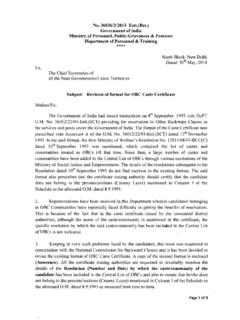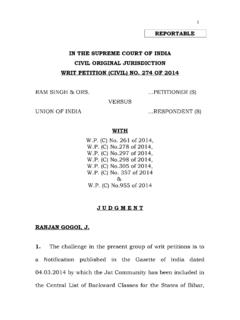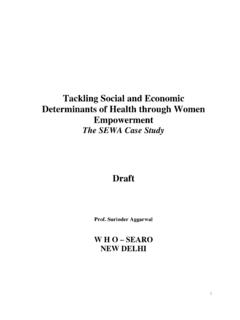Transcription of Editorial Board - National Commission for …
1 Editorial Board Shri A. K. Mangotra, Member Secretary, Editor in Chief Smt. Shilpa Taneja, Research Officer, Editor Shri D. K. Pandey, Research Investigator, Editorial Assistance INDEX Sl. No. Content Page No. 1. From the Chairperson s Desk 1-3 2. Chapter-I Introduction 4-11 3. Chapter-II Functions of the Commission 12-14 4. Chapter-III Composition of the Commission 15-19 5. Chapter-IV Work done by the Commission 20-51 6. Chapter-V Annual Accounts 52-76 Annexures 77 Annexure- I: DOPT (SCT) dated 8th September 1993. 78-83 Annexure-II: DOPT No. 36033/3/2004-Estt.(Res.), dated 09th March, 2004 84-85 Annexure-III: DOPT No. 36033/3/2004-Estt.(Res.), dated 14th October 2008. 86-87 Annexure-IV: DOPT No. 36033/1/2013-Estt.
2 (Res.), dated 27th May 2013. 88-89 Annexure- V: Gazette Notification , dated 90-92 Annexure-VI: Gazette Notification , dated 93-94 Annexure-VII: DOPT No. 36036/2/2013-Estt.(Res.), dated 30th May 2014. 95-97 Justice V. Eswaraiah Chairperson (Former Acting Chief Justice High Court of Andhra Pradesh) (Status of Union abinet Minsiter) National Commission FOR BACKWARD CLASSES MINISTRY OF SOCIAL JUSTICE & EMPOWERMENT GOVERNMENT OF INDIA TRIKOOT-1, BHIKAJI CAMA PLACE, NEW DELHI-110066 TEL: 011-26183152 FAX: 011-26182388 E-mail: From the Chairperson s Desk The year 2014-15 has seen some momentous developments in the working of the National Commission for Backward Classes. The Judgement of the Hon ble Supreme Court in the case of Ram Singh & Ors. Vs. Union of India & Ors ( (C) No. 274 of 2014) dated 17th March, 2015 has come as a landmark Judgment for securing the social justice and protect all the genuine backward classes of the country.
3 Firstly, the Judgement very clearly lays down the yardsticks (and the quality of data) which are to be kept in mind when deciding about inclusion of new classes into the lists of OBCs. Not only this, the Judgment has exhorted the Government not to confine itself to identifying castes as backward classes but also to keep an eye open for newer forms of backwardness which are emerging in the society. 1 Backwardness cannot be determined on the basis of any mathematical formula and its determination should also cease to be relative. Feelings of historical injustice and possible wrong inclusions in the past cannot be the basis for further inclusions. The Judgment stresses the fact that the gates would be opened only to permit entry of the most distressed . In this case the Hon ble Supreme Court found that the advice of the NCBC was adequately supported by good and acceptable reasons which furnished a sound and reasonable basis for further consequential action on part of the Union Government.
4 By this Judgment, the Hon ble Supreme Court has strengthened the hands of NCBC and given a clear direction in which to move on the path of determining backwardness for the purposes of inclusion/exclusion from the list of OBCs. The NCBC has already started identification of newer forms of backwardness. Recommendations have already been made for including all transgenders as OBCs. As a next step in this direction, the NCBC is considering the case of orphans for inclusion in the list of OBCs. This case is presently under consultation with the State Governments. Apart from this Supreme Court Judgment, there have been major initiatives taken by the NCBC on long pending issues which had not been adequately addressed in the past. These pertain to:- i) Rationalization of the Rule of Exclusion ii) Sub - categorization amongst OBCs iii) Socio - Economic Caste Census 2011 iv) Decadal review of OBCs list 2 During the year, the NCBC has taken the bull by the horns and has tackled all the above four issues.
5 Details of action taken on all the four these issues are included in this annual report. Suffice it to say, the NCBC has submitted their full-fledged reports and recommendations to the MoSJE on all the above. If implemented in letter and spirit, these reports will go a long way in addressing the burning issues being faced today by the country s OBCs. I would like to thank all my Brother Members on the Commission who have assisted in all meetings and public hearings with their views, opinions and suggestions. The Research and Administration wings have been putting in their best efforts to help NCBC achieve its aims and objectives. I also would like to place on record the efforts of the Editorial Team which has put together a completely different annual report.
6 3 Chapter -1 Introduction The Preamble of the Constitution of India aims to achieve the objective of securing to its citizens social, economic and political justice, liberty, equality and fraternity. It also indicates the methodology to be followed for reaching this goal of providing social justice. Article 14 of the Constitution enjoins upon the State to provide to all persons equality before law and equal protection of the laws. The principle of right to equality is further reiterated in positive and affirmative terms in Articles 15 and 16. Article 15(1), prohibits discrimination of any citizen and under clause (5) of Article 15, the State is empowered to make special provisions by law for advancement of any socially and educationally backward classes of citizens in the matter of admissions to the educational institutions.
7 Special care was taken to declare equality of opportunity in the matter of public employment through Article 16. Clause (1) of this Article declares that in the matter of public employment or appointment to any office under the State, all citizens of this country shall have equality of opportunity. At the same time, Clause (4) declares that nothing in this Article shall prevent the State from making any provision for reservation in appointments or posts in favour of any backward class of citizens which, in the opinion of the State is not adequately represented in the services under the State. In order to fulfil the objective of providing equal opportunities to the weaker sections of the society, on the recommendations of Mandal Commission , Government of India, vide No. 36012/31/90-Est. (SCT) dated 13-8-1990, provided 27% reservation in Central posts and services to Backward Classes.
8 This was amended by dated 4 NCBC, Annual Report-2014-15 as follows:- 2(i) Within the 27% of the vacancies in civil posts and services under the Government of India reserved for SEBCs preference shall be given to candidates belonging to the poorer sections of the SEBCs. In case sufficient number of such candidates is not available, unfilled vacancies shall be filled by the other SEBC candidates. However, its operation was challenged in the Supreme Court. The Supreme Court in its landmark judgement dated 16-11-1992 in Writ Petition (Civil) No 930 of 1990, Indra Sawhney etc. etc. Vs Union of India & Others etc. etc. (1992) SCC217, popularly known as the Mandal Case Judgement held the No. 36012/31/90-Est. (SCT) dated 13-8-1990 to be valid and enforceable subject to the exclusion of the socially advanced persons/sections ('Creamy Layer' as it was termed) from the notified Backward Classes clause 2(i) of dated was read down to classify the OBCs on the basis of degree of social backwardness.
9 Another direction of the Supreme Court required the Government of India, and each of the State Governments and Administrations of Union Territories to constitute a permanent body, in the nature of a Commission or Tribunal, for entertaining and advising the respective governments on the requests for inclusion and complaints of over-inclusion or under-inclusion in the lists of Backward Classes and also directed that the Advice tendered by such body shall ordinarily be binding upon the concerned Government. In pursuance of this direction of the Supreme Court, the Government of India enacted the National Commission for Backward Classes Act, 1993 (Act No. 27 of 1993), setting up a National Commission for Backward Classes at the Centre. The Act came into effect on the 2nd April 1993.
10 The Government of India constituted the Commission by its Notification No. 12011/34/BCC(C)/Pt. I dated 14th 5 NCBC, Annual Report-2014-15 August, 1993 with the first team of five Members with a tenure of three years. Presently, the VII Commission is working under the Chairmanship of Hon ble Justice Review of Income Criteria The expert committee appointed by the Government of India submitted its creamy layer report on and to review the income criteria every three years or earlier. The first review of the income criteria to exclude socially advanced persons/sections among OBCs was entrusted to the NCBC on 6th October, 2003. The Commission submitted its report on 23rd January, 2004 and recommended that the income limit to determine the socially advanced persons/sections among OBCs be raised from Rs.





